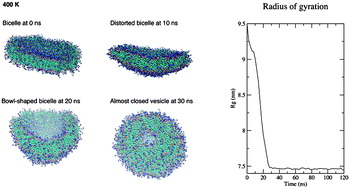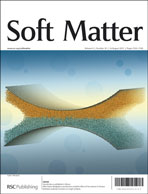Effect of simulation temperature on phospholipid bilayer–vesicle transition studied by coarse-grained molecular dynamics simulations
Abstract
Computer simulations of the spontaneous self-assembly of phospholipid vesicles (liposomes) have found a bicelle intermediate which curls up into a vesicle. Although coarse-grained (or intermediate-resolution) molecular dynamics simulation studies have been conducted at intermediate (323 K) to high (360 K) temperatures, it is unclear if there exists an ‘optimal’ temperature that accelerates the bicelle-to-vesicle transition process yet do not cause large deviation of structural properties as observed from simulations at the lower temperatures. Further, use of a lipid mixture that includes a certain fraction of lipids preferring negative curvature (such as dipalmitoylphosphatidylethanolamine or DPPE) has been shown to again accelerate the transition. But what is the interplay of the temperature and DPPE ratio in accelerating the transition? By conducting a systematic study of simulation temperatures (323 K, 330 K, 340 K, 350 K, 360 K, 380 K, and 400 K) and DPPE percentages (0, 10, 20, and 27) for dipalmitoylphosphatidylcholine (DPPC) bicelles, I found that 340 K and 10% DPPE would give a DPPC : DPPE vesicle (<20 nm diameter) with structural properties close to the reference state (pure DPPC vesicle at 323 K) but at a much reduced computational cost (about 12× lower). This simulation finding has implications in the acceleration of coarse-grained molecular dynamics simulations of large unilamellar vesicles (50–500 nm diameter) for drug delivery applications.


 Please wait while we load your content...
Please wait while we load your content...